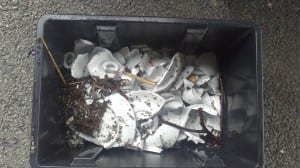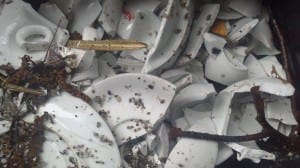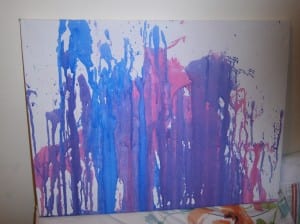Yesterday, Friday 19th of April was our multimedia work in progress day. The day was an opportunity for us to show the rest of the group a sneak peak of what our performance may be like, looking at how certain aspect would go and whether or not things needed to change etc. As well as showing our ideas and progress to the group, it was also a chance for us to see what other groups had come up with. I think the day was very successful because not only did we receive a great deal of useful and critical feedback from our peers, we were also able to support their initial ideas and consider things to help improve on their performance piece which they may not have considered their selves.
For our performance, we had considered having multiple stations, all with different elements within each of them which would help to determine / change mood. For the work in progress we decided that it would be beneficial for us to only try out a few of these sections.
The stations we decided on showing to the group was smashing crockery, popping paint balloons and sensory deprivation. For smashing crockery and popping paint balloons we thought it was best to conduct these excises outside, for health and safety reasons along with creating mess within the studio space.
Because we had limited materials for the day, we explained to members of the group that they could either participate in one or the other, so everybody would have the chance to do something if they wished.
Smashing…
So, with a suitcase with cups and saucers in, we asked people to collective come and collect an item and throw it into a specific area (out of the way of the general public). Some people threw the items with great force and anger where other members gentle tossed it into the air. It was quite evident though that the act of smashing helped to relieve stress and anger, making the individual feel a lot better and less stressed. The reason for this exercise was to see if something as simple as smashing a plate would in fact change an individual’s mood. Evidence showed that this section was a success with the ability to change a person’s mood. One member of the group said that she had had a rubbish start to the day and just by smashing that one item, automatically lifted her mood and helped towards her being as tense and stressed. The problem s we discovered with this section is how wide spread the pieces of broken crockery actually went. With this in mind we would then need to think of how we would contain the pieces on the day, whether it was by throwing things into a large box / container or sectioning off a piece of the room where odd bits and pieces wouldn’t fly off in all directions. A member of the group also asked us if we had thought about the use of protective eyewear, for it could be seen as a health and safety matter if a small piece was to backfire and end up in somebody’s eye. With this in mind, everybody agree it would be best to provide audience members with protective eyewear such as goggles on the day.
Once we had finished with this section, some members of our group cleared away all the broken crockery. Here is an image of the result of the smashed up pieces of crockery.
Popping…
The other experiment which we conducted outside was the popping of paint balloons. For this section we had filled several balloons with a mixture of paint and water. We then attached them to a small canvas (we would be using one on a much larger scale on the day) with the use of string and drawing pins. The purpose of this was to ask members of the group to simply go up and pop a balloon. Even though we had provided aprons and protective covering for their clothes, some members were reluctant to participate for they didn’t feel comfortable in getting too close. However, the individuals that did take part didn’t expect the result to be so beneficial. They said it gave them a sense of fun and made them think back to being a child. It was also clear in this station how the popping of a single paint balloon lifted an individual’s mood by making them happy and feel childlike. This was the kind of response we were hoping for and the fact it worked was very promising to us. However, some things didn’t quite go to plan, and by conducting this exercise for the work in progress helped us to overcome this. One problem was that not all members were willing to take part because they were afraid of getting splashed, even though we had provided them with protective wear for their clothes. A way in which we decided to overcome this was by suggesting to them would they feel more inclined to take part if they had the choice of popping the balloons but with the use of a pin of the end of a long stick? The reaction to this seemed a lot more willing and so this was something we could look into using for the final performance. Another problem that we faced with this section was that some of the balloons were not blown up enough so they did not actually pop when stabbed with a pin. This was a little disappointing for us but we knew the way to overcome this problem was to make sure on the day they were blown up to a particular size, which meant they would more elasticated making them more prone to popping when pieces with a pin, meaning the paint would explode and cover the canvas provided.
Here is a picture of the canvas once the balloons had been popped. We thought that it looked good and we liked how the different colours mixed together. This is just a small example of what our final product may look like as we will be using it on a much larger scale with a variety of different colours.
Sensory deprivation…
We conducted this experiment inside the studio. For this we used headphones, an iPod, scarves/ blindfolds and a chair. We asked for a member of the group to volunteer to sit on the chair and endure the experience we were going to offer them. We asked them what kind of mood they were feeling so it would give us an indication of what kind of music we would play to them. If they felt happy then we would play sad music, or if they were angry we would play relaxing calming music. The participant was unaware of this though as we wanted to see if the contrast in music to how they were currently feeling would affect their mood. We tied the individual to the chair by hands and feet so they were unable to move or get away. Once they were listening to their chosen mood of music, without them knowing we changed the music to a contrasting piece. Whilst all of this was happening we were spinning their chair and moving it around the room to try and add to the sense of them not knowing where about they were. Taking away a person’s senses can be quite challenging and we found out as there are certain things such as smell and taste in which we could not manipulate.
The feedback from this exercise was interesting as the individual said to use how they didn’t expect the music to contrast with their current mood and in way it did have some impact on their mood afterwards. The problems with this exercise is how they said to us by seeing a spinning chair, they had a feeling they knew what we were going to do to them.
Out of the three different experiments we presented to the group the sensory deprivation had the least impact on the individual. This was beneficial towards us though as we were then aware of the problems within this section which meant we were then able to go away and develop on the idea.
The outcome of the day was very useful towards us because the other members of the group helped us to give the different exercises trial and error, and they gave suggestions as what we could do to make each of the different sections better.
As well as asking them to participate within the different exercises, we asked them to post a tweet on the twitter page we had created for the performance, asking them to post how they were feeling and whether or not the stations had an effect on their mood. The reason we asked them to do this was so we had a physically piece of evidence with responses on instead of them just telling us as when people say something, overtime it gets forgotten, where as the use of a physical copy would last.



